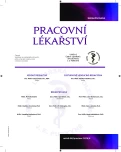Central nervous toxicity incidence during hyperbaric oxygen therapy depending on the scheme of breathing oxygen
Authors:
Oniščenko Boris
Authors‘ workplace:
Ústav leteckého zdravotnictví Praha, Oddělení bezpečnosti letů, vedoucí pracoviště MUDr. Petr Došel
Published in:
Pracov. Lék., 66, 2014, No. 4, s. 133-136.
Category:
Original Papers
Overview
The central nervous oxygen toxicity is probably the most dramatic complication of hyperbaric medicine. Fully developed it is manifested especially by a loss of consciousness and tonic-clonic seizures of the character of the epileptic grand-mal seizures. The incidence is estimated at approximately 1 fully developed form on 10,000 expositions (for the treatment of 250 kPa, 90 min., 100% O2). Although there is no evidence that it is harmful in the long run, it is certainly an unwelcome part of hyperbaric practice. In case of loss of consciousness and seizures in an enclosed space there is an increased risk of secondary injury and the risk of non-standard situations which may bring another complications both for the patient as well as for the healthcare provider. Preventing and minimizing the risk of this phenomenon is therefore a general request for the hyperbaric practice. The aim of this paper is to compare the incidence of the central oxygen toxicity and possible prodromal stages in different treatment schemes in our department. The main difference is the inclusion of the so-called air break during treatment and thus interrupting otherwise continuous oxygen breathing. The incidence of reported adverse effects associated with the subsequent interruption of the patient's ongoing treatment was reduced.
Keywords:
hyperbaric medicine – central oxygen toxicity
Sources
1. Bert, P. Barometric pressure: research in experimental physiology. Columbus: College book company, 1943.
2. Bitterman, N. CNS oxygen toxicity. Undersea Hyperbar. Med., 2004, 31, s. 63–72.
3. Kindwall, E. P. Hyperbaric medicine practice. Best Publishing Company, 2008, 75 s., ISBN 9-780941332-78-1.
4. Lambertsen, C. J. Effects of oxygen at high partial pressure. In Fenn W. O., Rahn H. Handbook of physiology. Bethesda, 1965, s. 1027–1046.
5. Butler, F. K., Thalmann, E. D. Central nervous system oxygen toxicity in closed circuit scuba divers II. Undersea Biomed., 2008, 13., s. 193–223.
6. Novomeský, F. Potápěčská medicína. Martin: Osveta, 2013, s. 139, ISBN 978-80-8063-397-4.
7. Mathieu, D. Handbook on hyperbaric medicine. Dodrecht: Springer, 2006, s. 747, ISBN 1-4020-4376-7.
8. Novomeský, F. Potápěčská medicína. Martin: Osveta, 2013, s. 137, ISBN 978-80-8063-397-4.
9. Welslau W., Almeling, M. Incidence of oxygen intoxication to the central nervous system in hyperbaric oxygen therapy. In A. Marroni, G. Oriani, and F. Wattle, eds., Proc. of the Intl. Joint Meeting od hyperbaric and underwater medicine. EUBS Milan 1996, s. 211–216.
10. Yildiz, S., Aktas, S., Cimsit, M., Ay, H., Togrol, E. Seizure incidence in 80000 patient treatments with hyperbaric oxygen. Aviat Space Environ Med., 2004, 75, s. 992–994.
11. Piantadosi, C. A. A mini-forum on air breaks and O2 toxicity in clinical HBO therapy. Undersea Hyperbaric Med., 2004, 31, s. 185–202.
Labels
Hygiene and epidemiology Hyperbaric medicine Occupational medicineArticle was published in
Occupational Medicine

2014 Issue 4
Most read in this issue
- Vacuum compression therapy in occupational medicine
- Central nervous toxicity incidence during hyperbaric oxygen therapy depending on the scheme of breathing oxygen
- Provision of health surveillance in the employees giving dialysis service from the occupational infection standpoint
- Health protection at work in the network of dialysis workplaces
